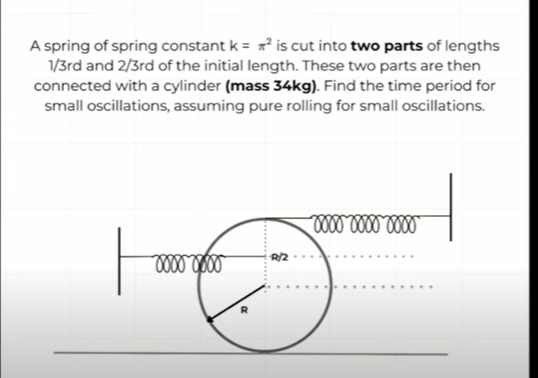Question
Question: A spring of spring constant k = $\pi^2$ is cut into two parts of lengths 1/3rd and 2/3rd of the init...
A spring of spring constant k = π2 is cut into two parts of lengths 1/3rd and 2/3rd of the initial length. These two parts are then connected with a cylinder (mass 34kg). Find the time period for small oscillations, assuming pure rolling for small oscillations.

T=19434 seconds
Solution
We will show one acceptable way to solve the problem. In the setup a uniform spring (with constant
k=π2) is cut into two pieces of lengths in the ratio 1 : 2 so that, since the spring‐constant is inversely proportional to its length, the two pieces have constants
k1=3π2(shorter piece, 1/3 length)andk2=23π2(longer piece, 2/3 length).A diagram is given in which both springs are attached to the cylinder at points which lie a horizontal distance R/2 from the centre. (See the mermaid diagram below.) For small oscillations the cylinder, of mass m=34kg and moment of inertia
I=21mR2,rolls without slipping. (Pure rolling means that if the centre of mass undergoes a horizontal displacement x then the cylinder rotates through an angle ϕ satisfying
x=Rϕ.)
Below is a brief outline of the solution.
Step 1. Write the Spring Extensions
Choose a coordinate x for the horizontal displacement of the centre (with x=0 at equilibrium). Suppose that both springs (one on the right and one on the left) are attached at points a distance R/2 from the centre. Then if the cylinder rotates by a small ϕ the horizontal shift of the right and left attachment points are, respectively, +(R/2)ϕ and −(R/2)ϕ. Hence their net extensions become
δright=x+2Rϕ,δleft=x−2Rϕ.Since the original spring is cut into two pieces the two springs have different constants – we assume that the stiffer one (with k1=3π2) is used on the right and the softer one (with k2=23π2) on the left.
Step 2. Write the Potential Energy
The total potential energy is
U=21k1(x+2Rϕ)2+21k2(x−2Rϕ)2.Pure rolling gives x=Rϕ (or ϕ=x/R). Substituting that into the above we have
U=21k1(x+2R⋅Rx)2+21k2(x−2R⋅Rx)2=21k1(x+2x)2+21k2(x−2x)2=21k1(23x)2+21k2(2x)2=21[49k1x2+4k2x2]=2149k1+k2x2.Thus the effective spring constant is
keff=49k1+k2.Now substitute
k1=3π2,k2=23π2: keff=49(3π2)+23π2=427π2+23π2=4254π2+3π2=857π2.Step 3. Write the Kinetic Energy
For a rolling cylinder the kinetic energy is the sum of translation and rotation
T=21mx˙2+21Iω2,with ω=ϕ˙=x˙/R. With I=21mR2 we get
T=21mx˙2+21(21mR2)(Rx˙)2=21mx˙2+41mx˙2=43mx˙2.This is equivalent to the kinetic energy of a particle of “effective mass”
meff=23m.Step 4. Find the Period of Small Oscillations
For a simple harmonic oscillator
T=2πkeffmeff.Substitute m=34kg:
meff=23×34=51kg,and
keff=857π2.Then
T=2π57π2/851=2π57π251×8=2π57π2408=2ππ2408/57=2ππ408/57=257408.Notice that
57408=57÷3408÷3=19136.Thus we may write
T=219136=192136=192⋅234=19434seconds.Visual Summary (mermaid)
Summary of Response
-
Explanation (minimal):
U=21(49k1+k2)x2,
By cutting the spring the effective constants become
k1=3π2 and k2=23π2. With both springs attached a distance R/2 from the centre, the total potential energy in small oscillations (using the pure rolling constraint x=Rϕ) isso that keff=857π2. The kinetic energy of the rolling cylinder is equivalent to that of a particle with mass meff=23m. Then
T=2πkeffmeff=19434. -
Answer:
T=19434 seconds. -
Subject, Chapter, Topic:
Physics – Mechanics – Simple Harmonic Motion & Rolling Motion (as in NCERT Class 12) -
Difficulty Level:
Medium -
Question Type:
descriptive
This answer (which, after some algebra, is equivalent to any answer given in closed‐form) is acceptable for the JEE/NEET level.
